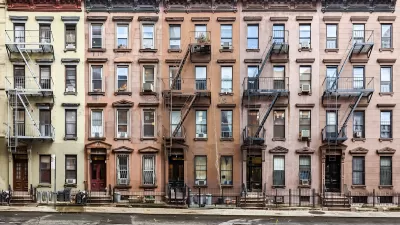While landlords and boosters are touting a ‘flood’ of returning residents to the city as the reason behind rising housing costs, one New Yorker doesn’t buy it.

Writing in Curbed, Lane Brown debunks the myth being perpetuated by real estate agents and landlords that New Yorkers are “flooding back” into the city, creating a deluge of demand for housing that, inevitably, has to get more expensive.
“I had lived happily in New York for more than two decades, through many disasters and rebounds, and I wanted to believe the story of its glorious post-COVID recovery,” Brown writes. But the claims just weren’t adding up. Brown went on to calculate how many New Yorkers had left the city: 317,107 between March 2020 and December 2021. “Outbound migration has slowed since then, but it hasn’t changed direction. By my count, the city lost another 97,794 in 2022, ranging between about 6,000 and 11,000 per month.”
Brown examined potential sources of the “phantom rebound,” but ran into a series of dead ends. Then Brown uncovered the role of RealPage Revenue Management Software, which uses an algorithm to recommend how landlords should price their rental units. “Some argue — including the plaintiffs of over a dozen class-action lawsuits filed in the wake of ProPublica’s story — that RealPage’s software allows individual landlords to keep their hands clean while indirectly colluding to inflate prices.”
Brown explains the history of the company and how it could be impacting New York City housing prices. See the source article for the full analysis.
FULL STORY: New Yorkers Never Came ‘Flooding Back.’ Why Did Rents Go Up So Much?

Alabama: Trump Terminates Settlements for Black Communities Harmed By Raw Sewage
Trump deemed the landmark civil rights agreement “illegal DEI and environmental justice policy.”

Planetizen Federal Action Tracker
A weekly monitor of how Trump’s orders and actions are impacting planners and planning in America.

Why Should We Subsidize Public Transportation?
Many public transit agencies face financial stress due to rising costs, declining fare revenue, and declining subsidies. Transit advocates must provide a strong business case for increasing public transit funding.

Understanding Road Diets
An explainer from Momentum highlights the advantages of reducing vehicle lanes in favor of more bike, transit, and pedestrian infrastructure.

New California Law Regulates Warehouse Pollution
A new law tightens building and emissions regulations for large distribution warehouses to mitigate air pollution and traffic in surrounding communities.

Phoenix Announces Opening Date for Light Rail Extension
The South Central extension will connect South Phoenix to downtown and other major hubs starting on June 7.
Urban Design for Planners 1: Software Tools
This six-course series explores essential urban design concepts using open source software and equips planners with the tools they need to participate fully in the urban design process.
Planning for Universal Design
Learn the tools for implementing Universal Design in planning regulations.
Caltrans
Smith Gee Studio
Institute for Housing and Urban Development Studies (IHS)
City of Grandview
Harvard GSD Executive Education
Toledo-Lucas County Plan Commissions
Salt Lake City
NYU Wagner Graduate School of Public Service





























